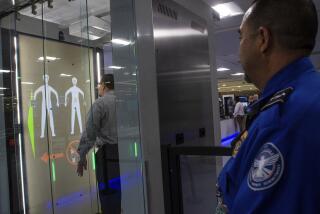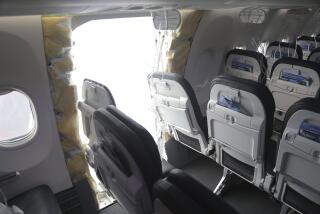FAA Moves to Boost Security at U.S. Airports
WASHINGTON — In the wake of the British announcement that it was a bomb that broke up Pan Am Flight 103, the Federal Aviation Administration said Wednesday that it will seek to tighten airport security in the United States by imposing additional countermeasures against terrorism as part of an “urgent review” of its security measures.
The agency declined to specify what steps it will take. The State Department, however, indicated that the new measures will concentrate on the processing of passengers and the handling of baggage and cargo.
The reports that plastic explosives had caused the blast aboard the Pan Am flight raised anew persistent concerns about the ability of airlines and airports to detect such sophisticated weapons.
Security experts said that even with the FAA’s stepped-up defenses in place, the aviation system is almost certain to remain vulnerable in the short term to plastic explosives. But they held out hope that an effective means to detect plastic explosives might be in place in U.S. airports within the next few years.
The metal detectors and X-ray machines that form the staple of current airport security can do little to identify plastic explosives--light, powerful weapons composed of non-metallic elements and able easily to be re-formed into innocuous shapes.
But a newer line of explosives-detecting technology, which “sniffs” passengers and baggage to detect concentrations of nitrogen present even in plastic explosives, is already in place at U.S. embassies. It has been tested by its manufacturer, Thermedics Inc. of Woburn, Mass., for use in the aviation system at Boston’s Logan Airport.
Another kind of technology, which bombards baggage and cargo with neutrons to detect the nitrogen concentrations, is even closer to maturity, the experts said.
A neutron-bombardment device has been tested successfully under FAA auspices at the Los Angeles and San Francisco airports for the last 18 months, they said. Under a contract awarded last month, the first of five such machines is scheduled to be delivered to the FAA next July by its manufacturer, Scientific Applications International Corp. of San Diego.
False Alarms Possible
Proponents of the neutron-bombardment device acknowledge that the technology remains far from foolproof, able to detect only 95% of explosives and liable to raise two or three false alarms on each flight load of luggage.
Each machine, moreover, will cost nearly $1 million and would be able to search only about 600 bags an hour--meaning that most airlines would have to buy more than one machine for use at each airport to avoid major delays.
Those factors have in the past caused critics to dismiss the technology as imperfect and too costly. Even proponents of the technology say that it will be at least two years before a sufficient number of explosives-detecting machines could be in place even in the country’s largest airports.
On Wednesday, however, both the FAA and representatives of the airline industry spoke enthusiastically about the new machines.
“The cost is not small, and no one is going to want to put these machines into airports unless the public feels threatened,” said Lee Grodzins, a physics professor at Massachusetts Institute of Technology and a consultant to the FAA. “But short of searching every bag, I cannot think of a method which will be as effective as this.”
“In light of recent events,” said Stephen Hayes, vice president for public relations at the Air Transport Assn., “we want to see the FAA do more to bring these so-called infant technologies into rapid maturity and get them on line at airports as soon as possible.
“There’s no question that using new equipment like this is going to result in more cost to the airlines and ultimately to the passengers. But when you’re talking about airline security, you do what you have to do.”
More to Read
Sign up for Essential California
The most important California stories and recommendations in your inbox every morning.
You may occasionally receive promotional content from the Los Angeles Times.










